What’s on the menu, Housekeeping, and Guy Things
In our story we hope to gain a deeper appreciation of the Eastern Bluebirds through a scientific understanding of their lives. To closely observe these colourful birds, I set camp 20 feet away from the nest box and I wait patiently for the parents to get accustomed to my car, myself and my photographic gear. When the bluebird female continued to do her bird thing and flew back to the nest with food, I knew that today’s assignment had just started.
We summarize our observations in (1) What’s on the menu, (2) Housekeeping chores & diaper duty, and (3) Male Gender Behavioural Patterns.

Eastern Bluebird Female With Insect
What’s On The Menu – The Eastern Bluebird diet
I have arrived at breakfast time. It’s early in the morning and it seems the bluebirds are feverishly gathering insects and take turns at feeding the chicks.
Both the female and male Eastern Bluebirds have the same hunting strategy to catch insects. The bluebirds first locate the insect with their excellent eyesight from a perch, then dive to the ground for the capture, and finally return to the same location. End of the hunting cycle. Oh, from time to time the bluebirds smash the insects two or three times on the perch as the victims are probably still alive.
During breeding, Eastern Bluebirds feeding grounds are on a 50 to 75 meters radius all around the nest. This proximity provided me with plenty of photographic opportunities during each of my visits to the nests.
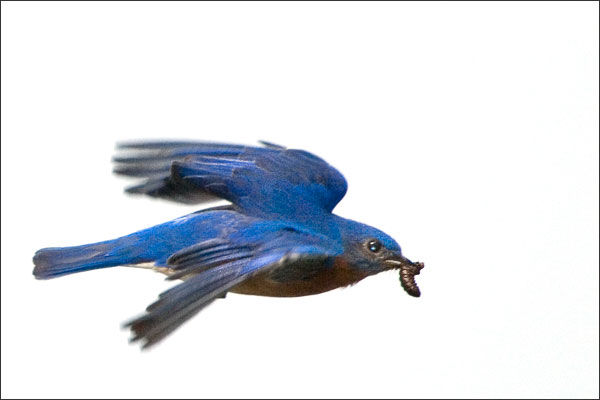
Eastern Bluebird Male In Flight With Mealworm
As the feeding frenzy continues for the next 4 hours, performed by both the male and female, I note that the Eastern Bluebird female is by far the most productive. Between me triggering the shutter and responding to changes in light conditions, I count a total of 24 feedings, with the female bluebird taking on the assignment 18 times. A clear win over the male.
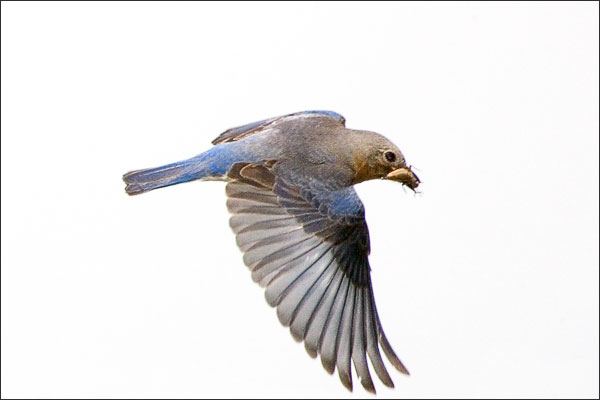
Eastern Bluebird Female In Flight With Mealworm
And just when I was starting to feel sorry for the female and start blaming the male for providing another living proof of male gender laziness, the Eastern Bluebird female left her perch, and, for 2 to 3 seconds she hovered above the male, just to perch back on the same branch. To note it was one of the more exceptional times when the male was returning with food.
Was the female grateful? Was the hovering of the Eastern Bluebird female a display of affection?
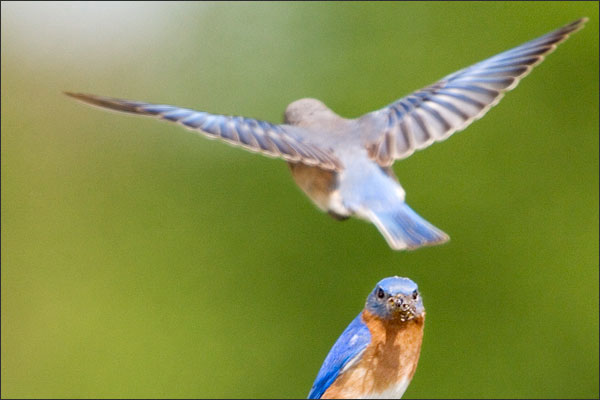
Eastern Bluebird Female Hovering Above The Male
I’ll leave it to your judgment. I was just relieved to see that there was light at the end of the tunnel.
Each inbound flight with food to the nest is noisily greeted by the bluebird chicks. Studies have shown that the Eastern Bluebird clutch may have 2 to 7 nestlings. Since each chick gets fed twice per hour, if I do the math, I am photographing a Eastern Bluebird family with 3 baby birds.
So, what exactly is on the Eastern Bluebird menu? During the summer months, bluebirds’ diet will consist mostly of insects such as grasshoppers, crickets and caterpillars. During the winter months, the Eastern Bluebird will feed on plant fruits such as dogwood and holly berries.
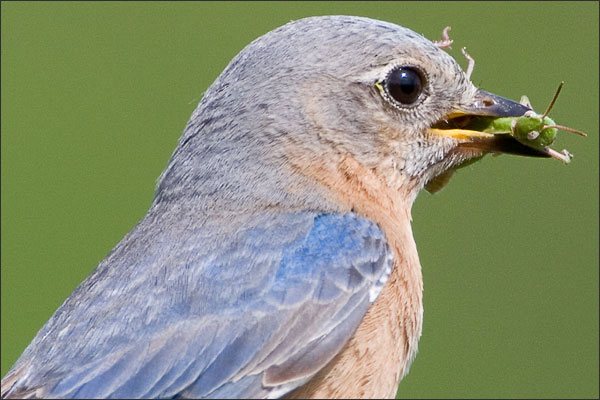
Eastern Bluebird Female With Grasshoper
Housekeeping Chores & Diaper Duty – Cleaning the nest to keep the parasites out
One of the most interesting aspects of the Eastern Bluebird parenting behaviour I have witnessed was the removal of the poop sac by the female from the nest box. Baby birds usually do not poop inside of the nest; instead they use a fecal sac which works like a diaper. The parent is then responsible to do the diaper duty, in this case the female; she literally takes out the trash by carrying the sac far away from the nest.
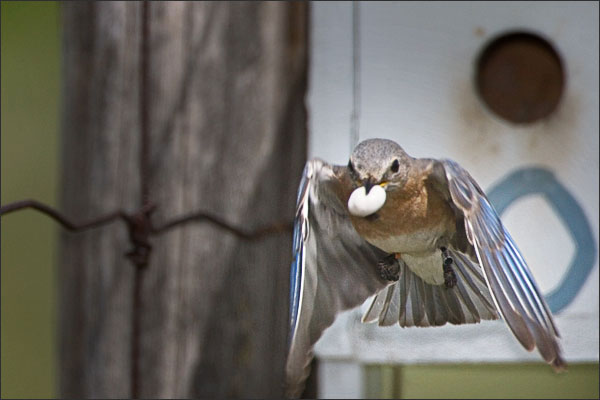
Eastern Bluebird Female With Poop Sac
I couldn’t see where the sac was disposed as the female Eastern Bluebird disappeared in the nearby foliage. But as a protective tactic she will carry the sac far enough to avoid drawing the raptors attention towards the nest.
One last note: I wonder if the sac in the photograph is one individual sac or multiple sacs combined together. If you have more information on this, please drop me a note.
| Feedback from our readers!
Although we have received from our readers more than one confirmation on the Bluebird female carrying a single fecal sac, we have decided to publish Megan’s response as being the most detailed and instructive. Thank you Megan and thanks everybody for all your feedback.
Mike Lascut
Hello!
My name is Megan and I am a biologist who is currently working with bluebirds. I ran across your photos (which are amazing, by the way) and saw your question in the commentary and thought I might answer it for you, just in case no one has yet. In the picture of the female carrying the fecal sac, she is carrying just one. Judging by the size of that thing, the chicks were probably at least 10 days old when that picture was taken. For my research, I handle chicks right after they are out of the egg up until a couple days before they leave the nest, so I’ve seen a lot of chick poop!
 ) They leave the nest when they are 18-21 days old. This also partially explains why the female was doing more of the feeding; males feed more when the chicks are young. Also, the picture in which the male and female are flapping their wings at each other they could be performing a behaviour called ‘wing-waving.’ They often do this after we’ve disturbed a nest box and it’s kind of like they’re saying, female “Is it okay to go down now?” male “Yes, yes, go ahead. Go feed the chicks!” It’s odd that you observed the male begging from the female. I’ll have to keep my eye out and see if I observe next time I’m out.
) They leave the nest when they are 18-21 days old. This also partially explains why the female was doing more of the feeding; males feed more when the chicks are young. Also, the picture in which the male and female are flapping their wings at each other they could be performing a behaviour called ‘wing-waving.’ They often do this after we’ve disturbed a nest box and it’s kind of like they’re saying, female “Is it okay to go down now?” male “Yes, yes, go ahead. Go feed the chicks!” It’s odd that you observed the male begging from the female. I’ll have to keep my eye out and see if I observe next time I’m out.
Hopefully this wasn’t redundant information!
Megan
|
UPDATE!
The Eastern Bluebird is one of the most read stories on MikePhoto.com and since I have a particular interest in Bluebirds and a full year has passed from my visits to the nests, I thought it is time to go back and record fresh material about their nest cleaning parenting behaviour. The update is now online at the Housekeeping Duty – An Eastern Bluebird Fecal Sac Update.
The update adds 2 photographs of feeding behaviour and a very short, slow motion movie, showing the Eastern Bluebird female carrying away the fecal sac. Don’t miss it!
Male Gender Behavioural Patterns – The Eastern Bluebird selfishness
My attention is always drawn to behavioral displays in animal species that specifically resemble human actions. Good similarities, for example, are when you witness parent affection towards its offspring. Most often we will witness behaviours such as feeding and protection. Bad similarities are when you witness “abusive” relationships such as the one illustrated below.
This is the perfect example of the male’s piggish appetite. Although surrounded by a buzzing mass of insects, on this day, I have recorded 32 frames with the bluebird male begging and trying to get access to the food captured by the female bluebird, sometimes in an assertive manner. And, the entire commotion is taking place in front of the hungry chicks’ nest.
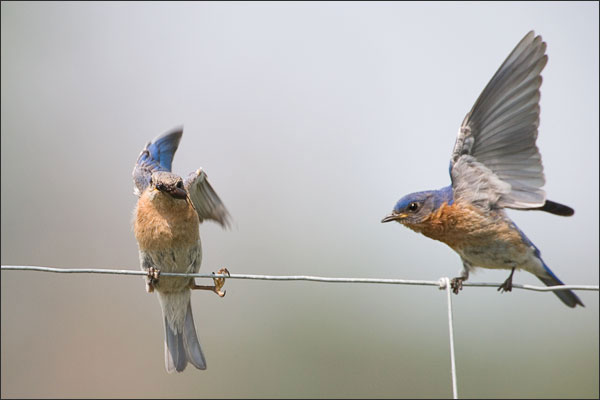
Eastern Bluebirds Arguing Over Food
With a frustrated flutter of the wings and the now-classic male avarice, the silent dialogue continues:
Eastern Bluebird Male: Gimme! I want it!
Eastern Bluebird Female: Go get your own food you lazy bird. This food is for the chicks. Our chicks! Oh, you brute, just fly away and gather yourself some food for once…
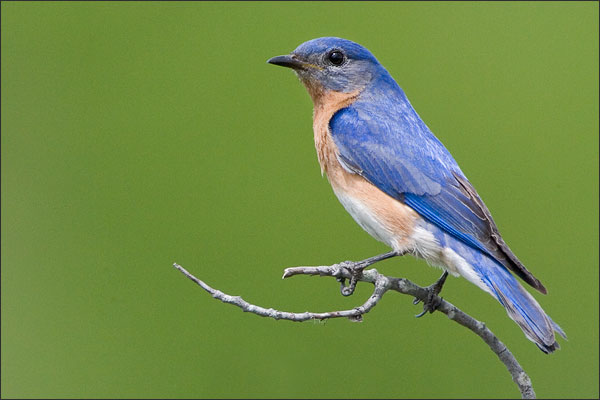
The Eastern Bluebird Male
Assignment Notes:
- The Eastern Bluebird assignment unfolded over a 3-week period and recorded a total of 454 colourful frames
- During this period 2 Eastern Bluebirds pairs were photographed at human-constructed nest boxes
- Both male and female in one of the pairs were banded
- Light conditions were excellent at all times with most photographs taken between 8:00 and 11:00 AM
- Multiple focal lengths were used, minimum 420mm, maximum 1000mm
Conservation
Returning on the fourth week, I find both nests empty. I hope the pairs were successful as Eastern Bluebird populations throughout Canada are diminishing.
Due to loss of habitat, increased use of pesticides and nest competition from non-native species, the Eastern Bluebird has suffered a drastic population decline in the past century. Helping the Eastern Bluebird making a comeback are the carefully constructed nest boxes on fence posts along rural roads.
| Mike’s Eastern Bluebird photographs featured on the cover and inside of the Neighbors magazine by Russell Publications |
 |
Kay MacNeil of Frankfort, Illinois is known in her hometown as “The Bluebird Lady.” This is because of her initiative to install bluebird houses throughout the community and bring the native “Gems of Blue” back to Northern Illinois. Russell Publications captured images of Kay inspecting bluebird houses, but we didn’t have professional photos of the bluebirds to share. We found Mike Lascut’s beautiful images of these feathered friends on his Web site (www.mikephoto.com) and contacted him to see if we could borrow an image or two for our feature story. If you asked readers in our area if they have seen a bluebird, most would say, “I haven’t seen a bluebird for years.” The Eastern Bluebird was once common throughout much of our state. In the past 50 years, the bluebird population has declined almost 90 percent. Mike’s photos allowed us to show our readers how beautiful these birds are. |
 |
Russell Publications has a circulation of about 16,000 readers in 9 south Chicago suburban towns. Those town papers are: Grant Park Gazette, Peotone Vedette, Beecher Herald, New Lenox Community Reporter, Monee Monitor, Crete Record, Manhattan American, Frankfort Neue Presse and Manteno News.
Tracy Ahrens, Neighbors section editor, Russell Publications, Peotone, Illinois
|
There’s an update to this story: Housekeeping Duty – An Eastern Bluebird Fecal Sac Update